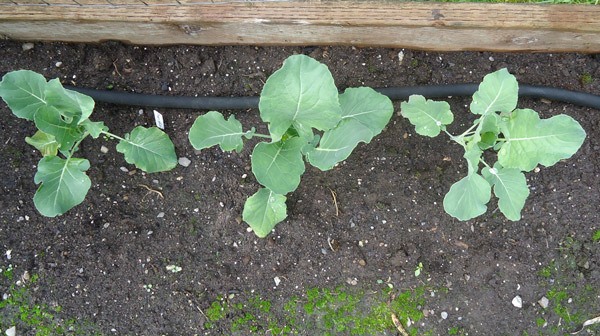Root depth
Vegetable plants with deeper roots require less frequent irrigation to maintain a healthy growth rate than those with shallow roots.
• Deep-rooted crops include asparagus, rhubarb, tomatoes and winter squash.
• Intermediate root depth plants include beans, carrots, peppers and summer squash.
• Shallow-rooted plants include arugula, celery, leeks, lettuce, onions, potatoes, radishes
Drought conditions in recent summers have challenged many local vegetable gardeners.
Even in times of water shortage, you can grow an abundance of fruits and vegetables by following these water-wise gardening practices.
Prepare the soil by incorporating organic matter. Organic matter helps to trap moisture, reduce surface crusting and run-off and encourage deep root formation, all of which improve plant drought tolerance.
To increase organic matter, apply 1-2 inches of compost to your garden beds each year before planting and mix it into the top 6-12 inches of soil. A single large application of compost does not do the trick; additions over many years are needed.
Plant with water conservation in mind. Consider growing vegetables with lower water requirements or those resistant to drought. Smaller varieties and those with short days to maturity usually need less water than their counterparts. Plants with deep root systems can draw moisture from deeper in the soil and often do better under drought conditions (See sidebar).
When planting, group plants with similar water needs together to increase the likelihood that all plants in a group will receive the desired amount of water (and not be overwatered).
Plant crops in blocks not rows and space plants so that their leaves will just touch when they are mature. The resulting shade will not only decrease water evaporation from the soil but discourage weeds which compete with your plants for water.
Build berms (slightly raised areas of soil) around individual larger plants such as tomatoes and peppers to help direct water to the root zone and reduce run-off.
Prevent water loss in the garden. Mulch applied to the soil surface greatly reduces evaporation and runoff, allowing water to soak in. Mulches also help control those thirsty weeds.
Recommended mulches include black plastic film, various types of paper (including newsprint and wrapping paper) and organic mulches (3-4 inches of materials such as compost, pine needles, wood bark and straw). Plastic is probably the most effective mulch for moisture conservation but organic mulches can be tilled into the soil after cropping to increase the organic matter.
Another way to prevent water loss from the soil is to limit deep cultivation. Stirring up the soil brings moist subsurface soil to the top, increasing moisture loss. Water loss also can occur from loose hose connections. Make sure to tighten your hoses and use o-rings in the base of the hose to prevent leakage.
Water wisely. Except for plants with very shallow roots (such as lettuce), water when your soil is dry 4-8 inches below the surface. Dig down to this depth and squeeze the soil in your hand; if it holds together without crumbling, the moisture probably is adequate.
Water during the cooler parts of the day (early morning or late afternoon) to minimize water loss due to evaporation.
Use watering systems that focus water at the base of plants and deliver water slowly. Soaker hoses and drip irrigation are ideal. Hand-watering also is good because the watchful gardener can respond to changing soil moisture conditions as watering occurs.
When you water, soak the soil to a depth of 6-8 inches to encourage roots to grow deep in the soil. With a deep root system, plants are better able to withstand dry periods.
Pearl of Wisdom
A cheap way to deliver water to the roots of larger plants such as squash or tomatoes is to punch holes in the bottom of a coffee can and bury it next to the plant at the time of planting. Pouring water into the can will deliver water close to the root zone with limited loss to run-off and evaporation.
For more
For more gardening information, attend a Saturday in the Garden presentation at the Master Gardener Demonstration Garden at 2711 Woodcock Road in Sequim. These free educational events are held on selected Saturdays. On
July 9 from 9 a.m.-noon, Clallam County Master Gardeners and members from the Olympic Orchard Society will talk about summer orchard maintenance.
Jeanette Stehr-Green is a WSU-certified Clallam County Master Gardener.



